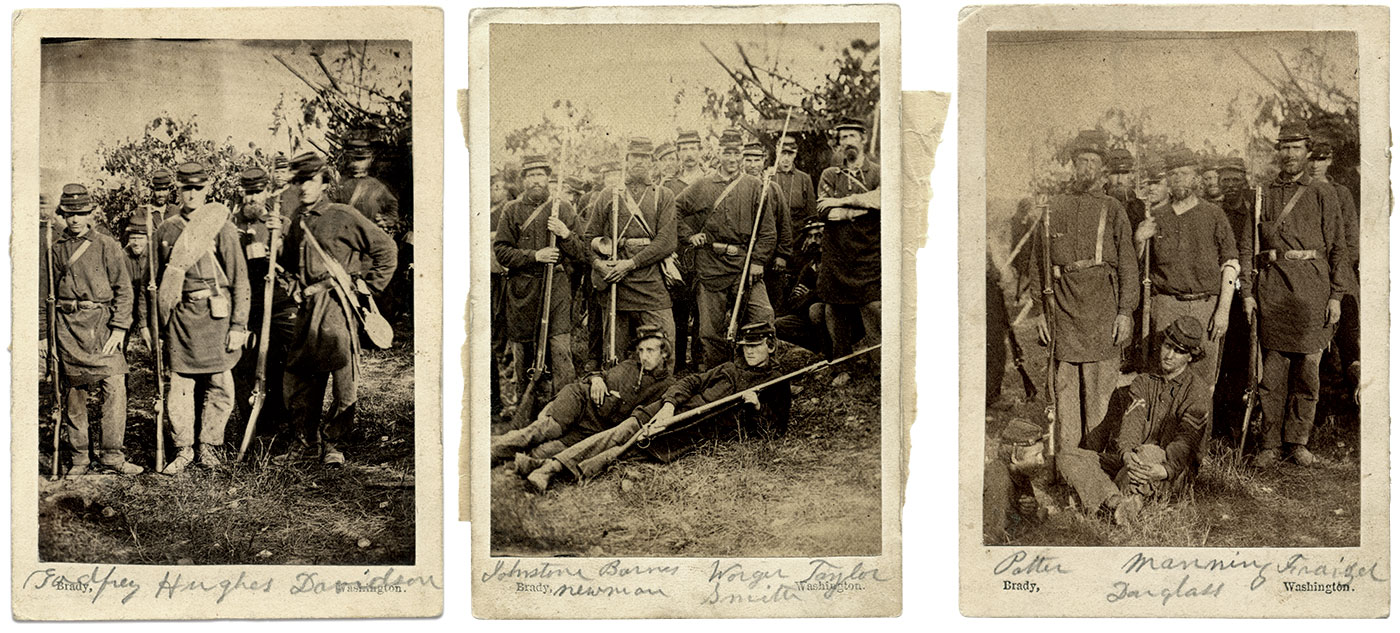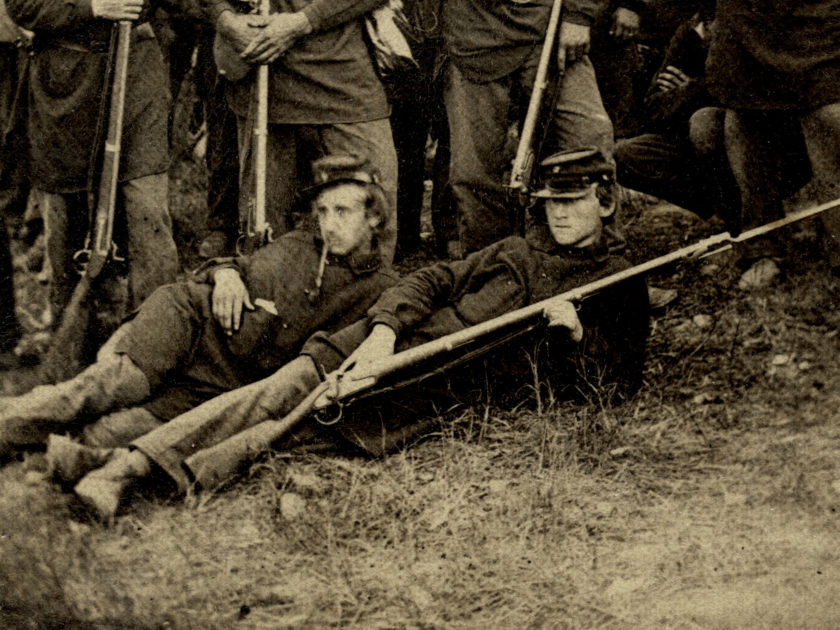By John Banks
Just days before the first major battle of the Civil War, at least 54 soldiers in Company F of the 2nd Rhode Island Infantry posed outdoors for an unknown Washington-based photographer employed by Mathew Brady. In six cartes de visite taken at the regiment’s “Bush Camp” at Centreville, Va., most of the Rhode Islanders, mustered into the federal army only six weeks earlier, seem relaxed, with none showing a hint of the momentous event soon to come.
In one of the images, 14 soldiers pose as a mischievous comrade peeks from behind two them. Two soldiers lie on the ground, gazing into the distance. Relaxing on his side, one of those men clenches a long pipe in his mouth, while another soldier standing in the background looks directly into the camera and appears to smile, a rarity in photography of this period.

Rhode Island Collection, Providence Public Library.
Another photograph includes a soldier casually sitting on the ground, his head tilted and both hands resting on his knees. On the extreme left, a young soldier, probably only a teenager, rests on elbows, staring away from the cameraman. Some of the soldiers wear the regiment’s distinctive three-button pullover shirt introduced by Col. Ambrose E. Burnside, the bewhiskered West Pointer who commanded the brigade that included the 2nd.
In another image, apparently taken at the edge of a wood, only three soldiers are featured: Cpl. Francis Ronien (also spelled Ronain) of Pawtucket, and brothers James and John Newell, privates from Smithfield. They stand with their newly issued muskets, Ronien’s weapon towering at least a foot above him.
Soon, the lives of these soldiers in these images, discovered in the public library in Providence, R.I., would dramatically change.
“Deserters and prisoners are frequently passing through our lines,” a 2nd Rhode Island soldier, identified only as “Tockwotton,” wrote on July 20, 1861, the night before the First Battle of Bull Run, “indicating weakness on the part of our foe, but I lay down with the anticipation of a dire conflict on the morrow.”

Rhode Island Collection, Providence Public Library.
The 2nd led their brigade, commanded by Burnside, into action the next day. “The battle commenced instantly and fiercely,” wrote Tockwotton. “I can compare it to nothing but the mysterious storm spoken of in the Apocalypse, only every drop was a ball, which mowed, and smote, and cut, with the force of lightning.”
The Bull Run butcher’s bill for the regiment was 56 wounded and 28 killed. The list included Maj. Sullivan Ballou, who would be remembered by a later generation for his poignant farewell letter to his wife.
Also on the list was Cpl. Ronien. As the battle raged, he “was struck by a shell, which took off his leg between the knee & hip,” according to another officer in the regiment. He died a short time later, probably at Sudley Church, which was used as a makeshift federal hospital. The regimental history noted, “He was a promising soldier, and fell with his captain bravely fighting.” The 25-year-old machinist left behind a wife, Mary, and two sons: 2-year-old Francis Thomas and infant, James Henry.
The Newell brothers fared somewhat better. John suffered a wound and fell into enemy hands. He wouldn’t be released from prison until May 1862. He survived the war and lived until 1889. For James, the war ended when he deserted at Harrison’s Landing, Va., on Aug. 8, 1862.
The surname Barnes appears in a handwritten identification on the front of one of the cartes de visite, but it’s unknown if that soldier is Pvt. Lewis Barnes of South Scituate or Pvt. Joseph Barnes of Smithfield. Lewis survived Bull Run physically unscathed, while Joseph was wounded there three times, captured and sent to a prisoner of war camp in Richmond. His captors released him on Jan. 17, 1862. In the six images, other soldiers, their names lost to history, also may have been Bull Run casualties.
In February 2014, the photographs surfaced when Kate Wells, Rhode Island collection librarian at the Providence Public Library, discovered them in a plastic bin of other donated items.

“I was excited to find these particular photographs for several reasons,” Wells recalled. “First, most of the cartes de visite and cabinet card portraits in our collection are far more formal and comparatively, these particular images are noticeably more relaxed showing soldiers at ease with one another and in the field. Second, because the men in the photographs are identified so that their personal stories become immediately more relevant. And lastly, because the accompanying note of provenance provided such great detail, including the specific dates and location of the portraits, allowing us to place the moment in such an important historical context.”
Wells posted the images and a short description on the library’s special collections blog. But somehow, the pictures largely escaped public notice.
Thankfully, the last names of many of the soldiers were recorded in blue ink under each of the images, which indicate they were once mounted in an album or scrapbook. An old, hand-written note found with the images notes the photos were taken July 17-18, 1861, only days before Bull Run. The slip of paper was signed by R.L. Johnstone, perhaps the soldier seen clenching the pipe in his mouth in one of the images—and the man who donated the images to the Providence Public Library more than 100 years ago.
References: Providence Evening Press, July 20 and 25, 1861; Francis Ronien pension file, National Archives.
A longtime journalist and Civil War blogger, John Banks is an editor at ESPN. Previously, he worked for theDallas Morning News, Baltimore News-American and Martinsburg (W. Va.) Evening Journal. He has authored two Civil War books published by The History Press, Connecticut Yankees at Antietam (2013) and Hidden History of Connecticut Union Soldiers (2015). He lives in Connecticut with his wife and two daughters. Contact him at jbankstx@comcast.net.
SPREAD THE WORD: We encourage you to share this story on social media and elsewhere to educate and raise awareness. If you wish to use any image on this page for another purpose, please request permission.
LEARN MORE about Military Images, America’s only magazine dedicated to showcasing, interpreting and preserving Civil War portrait photography.
VISIT OUR STORE to subscribe, renew a subscription, and more.

